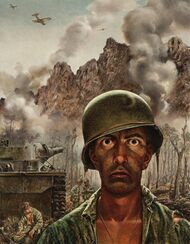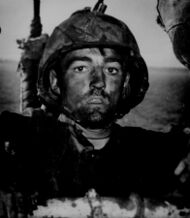Medicine:Thousand-yard stare


The thousand-yard stare (also referred to as two-thousand-yard stare) is a phrase often used to describe the blank, unfocused gaze of people experiencing dissociation due to acute stress or traumatic events. It was originally used in reference to war combatants and the post-traumatic stress they exhibited, but is now used more generally to refer to anyone in a stressful situation, or to people with certain mental health conditions.[1]
The thousand-yard stare is sometimes described as an effect of shell shock or combat stress reaction, along with other mental health conditions, but it is not a formal medical term.[1][2][3]
Origin
The phrase was popularized after Life magazine published the painting Marines Call It That 2,000 Yard Stare by World War II artist and correspondent Tom Lea,[4] although the painting was not referred to with that title in the 1945 magazine article. The painting, a 1944 portrait of a nameless Marine at the Battle of Peleliu, is now held by the United States Army Center of Military History in Fort Lesley J. McNair, Washington, D.C.[5] About the real-life Marine who was his subject, Lea said:
He left the States 31 months ago. He was wounded in his first campaign. He has had tropical diseases. He half-sleeps at night and gouges Japs out of holes all day. Two-thirds of his company has been killed or wounded. He will return to attack this morning. How much can a human being endure?[6]
When recounting his arrival in Vietnam in 1965, then-Corporal Joe Houle (director of the Marine Corps Museum of the Carolinas in 2002) said he saw no emotion in the eyes of his new squad: "The look in their eyes was like the life was sucked out of them". He later learned that the term for their condition was "the 1,000-yard stare". "After I lost my first friend, I felt it was best to be detached," he explained.[7]
See also
- Catatonia
- Combat stress reaction
- Defence mechanisms
- Hypervigilance
- James Blake Miller
- Post-traumatic stress disorder
- Shell shock
References
- ↑ 1.0 1.1 "Peleliu as a paradigm for PTSD: The two thousand yard stare - Hektoen International" (in en-US). https://hekint.org/2017/01/22/peleliu-as-a-paradigm-for-ptsd-the-two-thousand-yard-stare/.
- ↑ Mills, M. Anthony; Mills, Mark P. (2014). "The Invention of the War Machine". The New Atlantis (42): 3–23. ISSN 1543-1215. https://www.thenewatlantis.com/publications/the-invention-of-the-war-machine.
- ↑ Kudler, Harold (2017). "Combat Stress and Related Disorders". Principles and Practice of Hospital Medicine. McGraw-Hill Education.
- ↑ Life magazine, 6/11/1945, p. 65. link
- ↑ Jones, James, Tom Lea (illustration), (1975). - "Two-Thousand-Yard Stare" . - WW II. - (c/o Military History Network). - Grosset and Dunlap. - pp.113,116. - ISBN:0-448-11896-3
- ↑ LaRocque, Gene (1991). "War through the eyes of artists" (Transcript of televised broadcast). America's Defense Monitor, Program Number 438. Center for Defense Information. Archived from the original on 2006-10-26. https://web.archive.org/web/20061026072828/http://www.cdi.org/adm/Transcripts/438/. Retrieved 2006-10-27.
- ↑ Stone, Sgt. Arthur L. (2002-05-02). "Retired Sgt. Maj. Joe Houle recounts Vietnam tour". Marine Corps News. http://www.lejeune.marines.mil/News/tabid/1099/Article/511426/retired-sgt-maj-joe-houle-recounts-vietnam-tour.aspx.
 |
